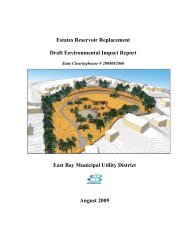Dingee Reservoir Final Seismic Report - East Bay Municipal Utility ...
Dingee Reservoir Final Seismic Report - East Bay Municipal Utility ...
Dingee Reservoir Final Seismic Report - East Bay Municipal Utility ...
- No tags were found...
You also want an ePaper? Increase the reach of your titles
YUMPU automatically turns print PDFs into web optimized ePapers that Google loves.
advanced using a hollow stem auger. Borings XV-12 and XV-14 were advanced using rotary<br />
wash drilling to reduce sample disturbance and stabilize the boreholes. The borings were drilled<br />
to a maximum depth of 50 feet below the existing ground surface through the dam fill and into<br />
the foundation materials.<br />
The subsurface materials were logged in the field by a District Materials Testing Technician,<br />
under the review and direction of the project manager. Samples for visual classification and<br />
laboratory index testing were obtained using a California (CAL) split-barrel sampler (3-inch<br />
outside diameter and 2.44-inch inside diameter). The CAL sampler was used in accordance with<br />
the American Society for Testing and Materials (ASTM) Method D 1586. The CAL sampler<br />
was driven 18 inches into the subsurface materials with a 140-pound automatic hammer falling<br />
30 inches. The penetration resistance (blow counts), measured in number of hammer blows to<br />
advance the sampler the final 12 inches (or a fraction thereof) of the 18-inch drive, were added<br />
and shown on the boring logs at the appropriate sample depth.<br />
Relatively undisturbed samples were obtained by using 36-inch long, thin-walled Pitcher tubes<br />
coated with resin (3-inch outside diameter with 0.065-inch wall thickness). The Pitcher tubes<br />
were used in accordance with the ASTM Method D 1587. The Pitcher tubes were advanced by<br />
steadily applying both hydraulic pressure and by rotary drilling appropriate to the resistance of<br />
the soil and rock.<br />
After careful withdrawal from the ground, the samples were visually inspected. Selected<br />
samples for index testing obtained with the CAL sampler were capped, taped, labeled, and<br />
transported in a padded box. The Pitcher tube samples were carefully placed upright, sealed with<br />
plastic caps, taped, and cleaned of disturbed soil at the ends of each tube.<br />
Field data and laboratory test results were used to classify the subsurface materials and to<br />
prepare boring logs that are presented in Appendix A. The boring logs include a visual<br />
classification of the soils based on the Unified Soil Classification System; an estimate of the<br />
relative density of cohesionless soils or consistency of fine-grained soils based on the blow<br />
counts; color, plasticity and moisture content. The laboratory test results for density, moisture<br />
content, Atterberg limits, fines content, clay content, specific gravity and triaxial compression,<br />
are included on the boring logs at the appropriate sample depth. The complete summary of the<br />
laboratory test results is included in Appendix B.<br />
At the completion of each borehole, the hole was backfilled with five-sack cement grout using a<br />
tremie pipe. The field technician observed the grouting process. Drill cuttings and fluids<br />
generated during drilling were temporarily stored on site in 55-gallon drums which were later<br />
delivered to Republic Services Inc. in Livermore, California for disposal according to applicable<br />
local, state, and federal regulations.<br />
3.2.3 Dam Surveillance Instrumentation<br />
Existing Piezometers<br />
The existing piezometers at the project dam site are the open well type, and are monitored<br />
monthly. No new piezometers were installed at the site during this investigation. The most<br />
<strong>Seismic</strong> Stability Evaluation <strong>Report</strong><br />
<strong>Dingee</strong> <strong>Reservoir</strong> Dam<br />
7<br />
August 2008

















